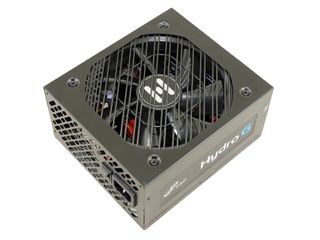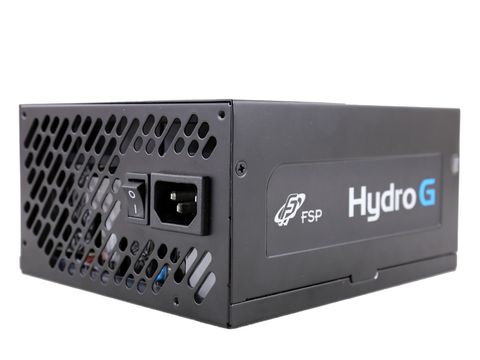Early Verdict
FSP's new PSU design manages to compete with other high-end platforms in this category. The HG650 offers good overall performance and thanks to its HDB fan and Japanese electrolytic capacitors its reliability should be excellent as well.
Pros
- +
Full power at 47°C
- +
Price
- +
Efficient
- +
Silent
- +
Ripple suppression
- +
Japanese electrolytic caps
- +
Fully modular
- +
Hold-up time
- +
Strong and efficient 5VSB rail
- +
HDB fan
- +
Warranty
- +
External design
- +
Changeable side stickers
Cons
- -
Can become really loud under extreme conditions
- -
3.3V load regulation
- -
PWR_OK hold-up time
- -
Noticed a small quality problem on the mainboard of our sample
Why you can trust Tom's Hardware
Introduction
Fortron Source Power was founded in 1995 and is now one of the largest PSU manufacturers in the world (according to Wikipedia, FSP ranks fifth). FSP manufactures all kinds of PSUs, from power bricks and open-frame units to ODM and OEM models, industrial units, even power supplies for LCD TVs. In addition to its OEM work, FSP also has a retail presence with 13 product lines classified into three main categories: premium, professional and mainstream.
FSP's new Hydro G line belongs to the premium category, along with FSP's Aurum PT and Aurum Pro models. Currently, the company only has three Hydro G configurations with capacities ranging from 650W to 850W. The series is still small and we expect FSP to broaden it in the near future. Still, the existing models target the most popular wattage categories, and with the right price tags, they can offer huge exposure to FSP if they perform well.
In this review, we're testing the lowest-capacity member of the Hydro G line, the 650W HG650 PSU.

All three units in the Hydro G line are 80 Plus Gold certified and fully modular. Most enthusiasts nowadays prefer modular cables over native/fixed ones, even if that makes the PSU more expensive. Full modularity makes installation significantly easier and, on top of that, cable management becomes less painful. Another advantage of modular cables is that experienced users can modify/sleeve them to their liking. In the past, there was some skepticism about modular cables, especially with high-capacity PSUs, since it was believed that extra connections could affect efficiency and load regulation. Over time, however, it was proven that the losses incurred through modular cables weren't large enough to raise alarms. This is clearly shown on PSUs like Corsair's AX1500i and EVGA's SuperNOVA 1600 T2, which boast modular cables and achieve Titanium efficiency. Given the right design and careful connections, power losses are minimized, diminishing the advantage of native cables.
Specifications
Besides 80 Plus Gold efficiency, the Hydro G 650 can deliver its full power continuously at up to 50 °C. It features all necessary safety features, including the over-temperature protection (OTP) that we always point out is so important. The power supply is cooled by a Hydro Dynamic Bearing fan, which has many similarities to Fluid Dynamic Bearing (FDB) fans. However, the FDB design and naming scheme is patented by Matsushita, which means that any company that uses this design, along with the bearing name, has to pay a fee. Because some companies don't want to do that, they invented similar bearing types with slightly different names; problem solved. The Hydro G 650 also features a semi-passive mode, which helps it to be silent under light loads.
FSP could have trimmed the supply's dimensions since it's a lower-capacity unit. However, the company instead recycled the same chassis on all of its Hydro G models to simplify production and cut costs.
Power Specifications
| Rail | 3.3V | 5V | 12V | 5VSB | -12V | |
|---|---|---|---|---|---|---|
| Max. Power | Amps | 25 | 25 | 54.16 | 3.5 | 0.5 |
| Watts | 150 | 649.92 | 17.5 | 6 | ||
| Total Max. Power (W) | 650 |
The minor rails are very strong for a modern PSU. Even 1kW+ units don't include such potent specs. The 5VSB rail is also beefy, especially for a 650W PSU, while the +12V rail can deliver the PSU's full power on its own.
Cables And Connectors
| Modular Cables | ||
|---|---|---|
| Description | Cable Count | Connector Count (Total) |
| ATX connector 20+4 pin (600mm) | 1 | 1 |
| 4+4 pin EPS12V (700mm) | 1 | 1 |
| 6+2 pin PCIe (500mm+150mm) | 2 | 4 |
| SATA (510mm+150mm) / Four-pin Molex (+150mm+150mm) | 2 | 4 / 4 |
| SATA (510mm+150mm+150mm+150mm) | 1 | 4 |
| SATA (510mm+150mm) / Four-pin Molex (+150mm) / FDD (+150mm) | 1 | 2 / 1 / 1 |
All cables are pretty long, while the distance between connectors is satisfactory (although less distance between the SATA connectors would come handy in a majority of cases). The number of PCIe connectors is high enough, but we would like to see at least a couple of EPS connectors instead of just one. There are plenty of SATA connectors; the same goes for four-pin Molex connectivity. Finally, all cables use standard 18-gauge wires, which are recommended by the ATX spec.
Power Distribution
Since this PSU features a single +12V rail, we do not have anything to say about its power distribution.
MORE: Best Power Supplies
MORE: Power Supplies 101
MORE: How We Test Power Supplies
MORE: All Power Supply Content
Aris Mpitziopoulos is a Contributing Editor at Tom's Hardware US, covering PSUs.
-
Onus I see a Performance Per Dollar chart, but so far I've not been able to find the price of this unit. What is it?Reply
-
Aris_Mp ReplyI see a Performance Per Dollar chart, but so far I've not been able to find the price of this unit. What is it?
It is 90 bucks
http://www.newegg.com/Product/Product.aspx?Item=N82E16817104200&nm_mc=AFC-C8Junction&cm_mmc=AFC-C8Junction-VigLink2-_-na-_-na-_-na&cm_sp=&AID=10446076&PID=3821802&SID=il40akd6as0035wt00053 -
mrjhh I remember FSP being an OEM for older computer vendors like DEC, so they definitely aren't a newcomer to the field. I'm glad to see they know how to build a modern supply.Reply -
Onus IMHO FSP has always had a solid but "middle-of-the-pack" reputation; not anybody's first choice, but a lot better than a lot of the junk being sold. Even their Raider units that got very critical reviews were acceptable as budget units in light use. In big box PCs, I'd certainly rather see FSP than HEC or Bestec.Reply
-
jeffunit I see "op amp amplifier" mentioned several times in the review.Reply
What is an "op amp amplifier"
Doesn't amp stand for amplifier in this context, which expands to op amplifier amplifier?
-
Odd naming scheme for a power supply. Hope it doesn't confuse anyone into thinking water goes well with it. :PReply
Always good to see some of the larger if less well known manufacturers putting out quality units. -
jeffunit ReplyWhat is an "op amp amplifier"
short for operational amplifier
op amp is short for operational amplifier.
op amp amplifier is short for operational amplifier amplifier.
You need to pay more attention to what is written. -
turkey3_scratch Good performing power supply. In terms of voltages and ripple, beats the EVGA GS. I would never hesitate to recommend this unit, if it is priced well of course, which it already is not.Reply

